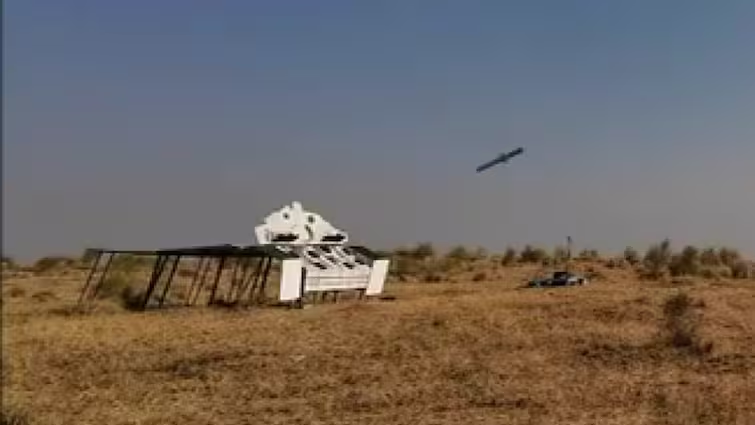India has taken one giant leap towards better defense systems after the indigenous Nag Mk-2 anti-tank guided missile, which was designed and developed by the Defence Research and Development Organisation, successfully test-fired at the Pokhran Field Range in Rajasthan on January 13. It had precision in firing and displayed all its credibility at the venue of the tests. With these trials being successful, Nag Mk-2 has been declared ready for induction into the Indian Army, thereby marking a remarkable milestone in India’s defense self-sufficiency and its burgeoning deterrence capacity.
Nag Mk2 Anti-Tank Fire-and-Forget Guided Missile destroyed precisely all the targets at maximum and minimum range during Field Evaluation Trials at Pokhran, thus validating its firing range and making system ready for inductionhttps://t.co/k5RlQQjhpv pic.twitter.com/oAKoIdUFtu
— DRDO (@DRDO_India) January 13, 2025
Nag Mk-2 is a fire-and-forget, lock-on-after-launch, third-generation anti-tank missile used for neutralization of modern threats armed with ERA. The Nag Mk-2 variant is supposed to have some “fire-and-forget” technology. Basically, the operator locks onto a target before launching and does not need to further guide this missile once it is launched. Hence, the system is highly potent in fast-paced and dynamic environments of a battlefield due to the minimal intervention of the operator. Additionally, the missile is designed to hit the soft spots of armoured targets through its tandem HEAT warhead, which provides it with significantly enhanced destructive capabilities.
The missile has a striking range of 7 to 10 kilometers. The Nag Mk-1 has a striking range of 4 kilometers. The expanded range of the Nag Mk-2 improves its versatility and effectiveness in numerous combat scenarios that call for long-range precision targeting. It will be launched from the Nag Missile Carrier, or NAMICA—an armoured vehicle that is derived from the Indian-made BMP-2 Sarath—which would ensure flexibility and mobility for the system’s deployment across a wide range of terrains, quickly and effectively.
Not only is the Nag Mk-2 missile system an important technological milestone for India but also a strategic step in dealing with the continuous security challenges the country faces from its neighboring adversaries, Pakistan and China. Manufacturing advanced weaponry at home is, for India. A significant step toward reducing its dependence on foreign suppliers and enhancing national security. The Nag Mk-2 will enhance the capability of the Indian Army and will be a strong deterrent against aggressive maneuvers along the border, particularly from Pakistan and China.
Against Pakistan, the Nag Mk-2 will give India an edge in anti-tank warfare. Pakistan presently uses the Barq laser-guided missile, a system based on Turkish technology. The Barq missile does not possess the “fire-and-forget” feature of the Nag Mk-2. Thus, it cannot effectively perform in scenarios of high-speed combat. It also exposes itself to countermeasures since the Barq system uses laser guidance. The Nag Mk-2 is a much more advanced and reliable system that gives India a significant advantage on the battlefield because it can track and engage targets without operator input after launch.
In the context of China, the Nag Mk-2 is a strong counter to China’s anti-tank capabilities, particularly the HJ-10 missile, which has a comparable range to the Nag. The Chinese HJ-10, on the other hand, uses a wire-guidance system that increases its vulnerability to electronic countermeasures and jamming. By comparison, the Nag Mk-2, using an advanced IIR seeker combined with top-attack, can hit a moving target effectively on modern armor vehicles. Such attributes as the soft underbelly for striking enemy tanks and the fire-and-forget capability put the Nag Mk-2 into a category of superiority not just in lethality but also resilience during modern warfare.
This time, the Nag missile system successfully tested is a moment when China and Pakistan have increasingly put India’s defense posture to the test. This comes with the 2020 Ladakh face-off, when both China and India began piling artillery and armored forces and realized a high demand for more advanced anti-tank capabilities. In this context, India immediately sought 200 Spike anti-tank missiles from Israel to address the instant requirements. With the induction of the Nag Mk-2, India will be less dependent on foreign sources for such crucial weapons and thereby add strength to indigenous defense capabilities as well as strategic autonomy.
Moreover, an operational deployment for this anti-tank missile will contribute to overall improvements in deterrence along both of India’s northern and western borders. Its strength in neutralising heavy armor has made it irreplaceable at the point of defense operations across India for the ability that this missile offers of countering Pakistani and Chinese armed threats.
Hence, the successful development and induction of the Nag Mk-2 anti-tank guided missile is a decisive step in India’s defense strategy. It underlines military superiority vis-à-vis two traditional adversaries, namely Pakistan and China, but shows the emergence of India on the world scale in terms of growing technological advancements with firm determination to establish strong self-reliance in defense. In fact, the more modern and developed the Nag Mk-2 is an indigenously available and will be crucial in border-guarding and establishing peace and stability in the region.
